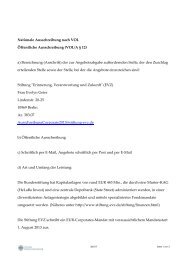chapter 2 - Stiftung "Erinnerung, Verantwortung und Zukunft"
chapter 2 - Stiftung "Erinnerung, Verantwortung und Zukunft"
chapter 2 - Stiftung "Erinnerung, Verantwortung und Zukunft"
Create successful ePaper yourself
Turn your PDF publications into a flip-book with our unique Google optimized e-Paper software.
Aidan McQuade<br />
invisibility of forced labor is in part due to the lack of familiarity with the legal and practical definition of<br />
forced labor. However, if the problem cannot be identified, it cannot be eradicated.<br />
My case studies also demonstrate how slavery emerges at the juncture of poverty, prejudice and governmental<br />
apathy and inaction. Clearly, slavery is as much a social issue as an economic or political one. Individuals<br />
and groups who are the target of social prejudice are especially vulnerable to exploitation and slavery. These<br />
groups include migrant workers in Western Europe and North America and people from scheduled castes in<br />
South Asia. However, the abolition movement has historically neglected this social dimension, which in part<br />
explains why slavery continues to persist despite political and social advances such as the promotion of democracy<br />
and the reduction of poverty.<br />
Over the past two centuries, the anti-slavery movement has tended to emphasize law and policy reforms,<br />
including the legal prohibition of slavery. While these developments are a necessary first step and have <strong>und</strong>eniably<br />
advanced the abolitionist cause, they are not sufficient to end slavery. As the ILO studies have demonstrated,<br />
forced labor remains a widespread problem, even today. In societies where social prejudice is a<br />
persistent problem, government authorities are also likely to be affected by these prejudices. As a result, government<br />
authorities may delay or hinder the implementation of anti-slavery laws, and fail to initiate measures<br />
to systematically tackle abuses. India, for example, still has millions of bonded laborers even though<br />
bonded labor was officially banned in 1976.<br />
In Europe, many states have ratified the 2005 Convention on Action against Trafficking on Human Beings,<br />
which guarantees minimum standards of protection for people who have been freed from trafficking. However,<br />
a 2008 European Commission report fo<strong>und</strong> that many states were failing to adequately implement the action<br />
plan. In the United Kingdom, there are worrying reports that trafficked people continue to be threatened<br />
with deportation. Once returned to their countries of origin, these men and women not only face the same<br />
horrors that originally caused them to flee their homelands, but are particularly vulnerable to re-trafficking<br />
and to added social prejudice as a result of their status as former forced laborers.<br />
The f<strong>und</strong>amental social dimension of slavery also has implications for the modern development agenda. Development<br />
and slavery have always been closely linked. The economies of Britain and other European slave<br />
trading nations were built on the profits of the Atlantic slave trade. By the same token, the countries and communities<br />
that have historically supplied trafficked labor have been further harmed by the economic and social<br />
effects of this trade. For example, the social and economic divides that erupted in the Angolan civil war can be<br />
traced back to the consequences of the Atlantic slave trade.<br />
Anti-Slavery International’s experience in the struggle against contemporary slavery demonstrates that the<br />
majority of slave laborers today come from the most impoverished and disadvantaged sections of society.<br />
Slavery often exists in poor communities; sometimes poor people enslave even poorer people, justifying this<br />
practice with prejudice and economic necessity. Once caught in a contemporary form of slavery, people are<br />
unlikely to be able to break out of the cycle of poverty and forced labor.<br />
Yet efforts to reduce poverty remain largely blind to the problem of slavery. It is entirely possible that even<br />
if we achieve the Millennium Development Goals, slaves will not benefit from these advances. Indeed, humanitarian<br />
and development efforts that fail to take into account the dynamics of power and prejudice in poor<br />
communities can exacerbate the problem of slave labor. For example, during the West African famine of 2005,<br />
the Niger anti-slavery and development organization Timidria discovered that some food-for-work programs<br />
were employing slaves who had been sent there by their masters. When the enslaved workers returned home,<br />
their masters confiscated their ration cards and collected the food for their own use. In other parts of West<br />
120<br />
<strong>Stiftung</strong> EVZ<br />
HUMAN RIGHTS AND HISTORY: A CHALLENGE FOR EDUCATION

















